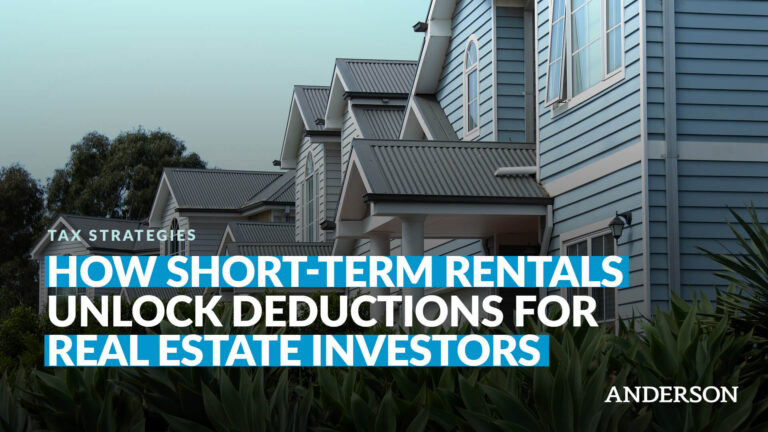
If you’re a real estate investor, the sweeping tax relief from 2025’s Big Beautiful Tax Bill revives key provisions from the 2017 Tax Cuts and Jobs Act, introducing powerful new benefits for property owners, small business operators, and high earners.
But what are those provisions, and how can you benefit from them? In this guide, I break down which tax strategies real estate investors should be paying attention to—especially Section 199A, Section 179, Opportunity Zones, and the SALT cap—and show you how to use each to reduce your taxes and increase your investment returns in the years ahead.
If you’re looking to understand Trump’s Big Beautiful Tax Bill for real estate, watch the full breakdown of all 17 provisions investors must know here.
How to Use Section 199A to Keep More of Your Rental Income
What is Section 199A of the U.S. Tax Code?
Known as the Qualified Business Income Deduction (QBI), Section 199A allows qualified business owners—including landlords and real estate investors operating as sole proprietors, partnerships, or S-Corps—to deduct a portion of their business income.
Under 2025’s tax code revisions:
- The deduction increases from 20% to 23% of qualified business income
- The deduction becomes permanent (it was originally set to expire)
This means more after-tax income flowing to investors. It’s not available to C-Corporations but is a big win for pass-through entities.
How Real Estate Investors Can Use It:
- Form an LLC taxed as a partnership or S-Corp to qualify as a pass-through entity
- Aggregate rental properties under one business if needed to meet the “trade or business” threshold
- Ensure your rental business generates W-2 wages or has enough property basis to meet IRS income tests
- Use cost segregation or accelerated depreciation to reduce AGI and remain under the income phaseout
Bottom Line: If you earn $200,000 in rental income and qualify, you could deduct $46,000 completely tax-free under the new 23% rate.
How to Maximize Deductions with Section 179
What is Section 179 of the U.S. Tax Code?
It lets businesses immediately deduct the full cost of qualifying equipment or property used for business instead of depreciating it over time.
Key changes in 2025:
- The deduction limit was raised to $2.5 million (up from $1 million), allowing businesses to expense more tangible property up front
- Phaseout threshold increased to $4 million
This creates a major opportunity for real estate investors doing different types of property upgrades, especially on income-producing or short-term rental properties.
Request a free consultation with an Anderson Advisor
At Anderson Business Advisors, we’ve helped thousands of real estate investors avoid costly mistakes and navigate the complexities of asset protection, estate planning, and tax planning. In a free 45-minute consultation, our experts will provide personalized guidance to help you protect your assets, minimize risks, and maximize your financial benefits. ($750 Value)
How Real Estate Investors Can Use It:
- Deduct the full cost of appliances, HVAC, security systems, and landscaping in the same year they’re purchased
- Use for improvements to short-term rentals that qualify as active businesses (i.e., you materially participate)
- Pair with bonus depreciation to maximize your front-loaded deductions
Pro Tip: Even cosmetic upgrades like flooring or kitchen fixtures may qualify under Section 179 if used in a rental business. When paired with a 1031 Exchange, Section 179 expense elections can be used strategically to increase depreciation on the new asset.
Bonus Depreciation (Section 168): 100% Write-Off
For real estate pros using cost segregation, bonus depreciation is a goldmine.
Trump’s 2025 tax bill restores 100% bonus depreciation for assets with recovery periods under 20 years, from 2025 through 2029.
How Real Estate Investors Can Use It:
- Run a cost segregation study to identify short-life assets (e.g., cabinets, plumbing)
- If using a 1031 Exchange, defer gains before layering in bonus depreciation on new property
- Write-off qualifying components in year one
- Generate paper losses that offset rental or even ordinary income (if you or your spouse qualify for Real Estate Professional Status)
Ideal For: Syndicators, passive investors, and high-income earners looking to wipe out gains from flips or other passive activity.
How to Defer and Eliminate Taxes with Opportunity Zones
What are Opportunity Zones?
They’re tax-incentivized areas where investors can defer, reduce, and eliminate capital gains taxes by investing in designated distressed communities.
Note: This strategy must be used on qualifying properties in eligible areas, which include U.S. territories like Puerto Rico.
2025’s tax bill adds a second wave of Opportunity Zones (OZ) running from 2027 to 2033, offering similar benefits:
- Temporary deferral of capital gains
- Step-up in basis after 5-7 years
- Tax-free gains if held 10+ years
How Real Estate Investors Can Use It:
- Sell appreciated assets (real estate, stocks, crypto) and roll the gain into a Qualified Opportunity Fund (QOF)
- Invest in projects within the new OZ zones, such as multi-family development, commercial rehab, or community infrastructure
- Use OZs to reset your portfolio—defer current taxes and create future tax-free growth
Pro Tip: One of the only ways to completely eliminate future capital gains tax—especially long-term capital gains from real estate sales.
How to Write-Off More State and Local Taxes with SALT
What is SALT?
It stands for State and Local Tax deduction—capped at $10,000 in 2024.
That cap has been especially harsh on investors and high-income earners in states with high property or income tax rates, such as California, New York, and New Jersey.
Here’s what the 2025 tax bill does:
- Increases the cap to $30,000
- Phases out the higher cap at $400,000 AGI
- Entirely phases back to $10,000 above that threshold
How Real Estate Investors Can Use It:
- Deduct more of your property taxes if you own multiple rentals or high-value homes
- Include state income taxes paid on real estate gains, interest income, or commissions
- Combine with thoughtful planning (e.g., bonus depreciation or retirement contributions) to stay below AGI thresholds and maximize your deduction
Result: This can unlock tens of thousands in additional deductions for investors in blue states, improving cash flow and reducing their federal tax burden. This type of relief reflects growing pressure on the federal government to address tax burdens in high-cost states.
Other Notable Provisions Affecting Tax Liability, Property Types, and Tax Returns
Beyond the four big hitters, several additional updates to the Internal Revenue Code in 2025 could benefit investors:
- The standard federal income tax deduction nearly doubles again.
While the bill nearly doubles the standard deduction once again, it still provides planning flexibility for those who may benefit more from itemizing, especially investors with significant mortgage interest, property taxes, or charitable contributions. - HSA contributions increase and now cover fitness-related expenses.
This allows investors and small business owners to expand their tax-free savings for health-related costs. This special rule will now allow you to deduct gym memberships, fitness equipment, wellness programs, and other medically prescribed preventive treatments. - No federal tax on tips and overtime for qualifying earners.
This provision offers targeted relief to the middle class and can improve overall tax efficiency, when paired with either standard or itemized deductions. - New $10,000 deduction for car loan interest.
This creates another potential itemized deduction for real estate investors using vehicles for business. - The Excess Business Loss (EBL) limitation becomes permanent.
The EBL cap limits how much real estate loss can be deducted against non-passive income, making it crucial to assess whether using the standard deduction or itemizing will yield greater tax relief.
Other Considerations for investors:
- Filing Separately Considerations.
Married real estate investors considering whether to file separately or jointly should be aware of how different filing statuses can impact eligibility for deductions like SALT, Section 199A, and HSA contributions. While filing jointly doesn’t necessarily reduce the amount paid in taxes, in some cases—such as managing AGI thresholds or loss limits—filing separately may provide more control and flexibility. - Social Security Impacts
Investors with large paper losses or substantial deductions could lower their AGI enough to reduce the portion of Social Security income subject to tax.
What the 2025 Tax Cuts Mean for Real Estate Investors
Real estate investors who structure smartly could:
- Reduce taxable income dramatically with the 199A and 179 expansions
- Write-off renovations and improvements immediately instead of slowly over 27.5 years
- Tap into a new decade of Opportunity Zone investing with tax-free upside
- Get long-awaited relief from unfair SALT deduction caps—especially in high-tax states
Don’t wait for the next tax year to modify your strategy. Now is the time to build the right structure and plan strategically to stay ahead of the curve.Schedule a FREE 45-minute Strategy Session with a Senior Advisor at Anderson Advisors. We’ll review your current tax strategy, identify where new provisions could apply, and map out a plan to minimize your taxes and protect your investments.















